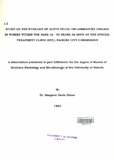| dc.contributor.author | Oduor, Margaret O | |
| dc.date.accessioned | 2014-01-24T11:48:22Z | |
| dc.date.available | 2014-01-24T11:48:22Z | |
| dc.date.issued | 1991 | |
| dc.identifier.citation | A dissertation presented in part fulfillment for the degree of Master of Medicine (Pathology and Microbiology)of the University of Nairobi | en_US |
| dc.identifier.uri | http://hdl.handle.net/11295/64295 | |
| dc.description.abstract | Acute Pelvic Inflammatory disease is a common gynecological problem in
many parts of Africa. It is one of the major problems seen at the Sexually
Transmitted Disease Clinic at Nairobi City Commission. In this study, 100
women within the ages 16-40 years with clinical signs and symptoms of
acute pelvic inflammatory disease and another 100 women within the same
age group but without clinical signs and symptoms of acute PID were
enrolled for the study.
The main objective of the study was to study the prevalence of Neisseria
gonorrlweae, Chlamydia trachomatis and Group B Streptococcus
(Streptococcus agalactiae) in women with clinical signs and symptoms of
acute pelvic inflammatory disease. Also to study the relation of acute PID in
terms of age, parity, marital status and contraception method used by the
patient. These findings were then to be compared to those seen in the
control women.
These women were screened for N. gonorrlweae, C. trachomatis, Group B.
Streptococcus using endocervical cultures on Thayer Martin, blood agar and
irradiated McCoy cell lines, and also by Gramstain of endocervical smears.
They were also screened for Treponema pallidum antibodies using rapid
plasma reagin card test.
Acute pelvic inflammatory disease was found to be more prevalent in the
younger age group below 25 years of age with a peak at 16-20 years.
Oral contraceptive use was correlated with a significantly decreased risk of
acute PID (odds ratio 0.78, p-value<0.05) and IUCD use correlated with a
significantly increased risk of acute PID (odds ratio 1.27, p-value<0.05).
Gonococcal acute PID was found to be commoner in a younger age group
than non-gonococcal acute PID. Risk of gonococcal acute PID was also found
to be significantly increased in the single, separated (odds ratio 3.12; pvalue-
cu.Ob) and the divorced women (odds ratio 1.67; p-value-cu.Ob).
Chlamydial acute PID was found to be commoner in a younger age group as
compared to non-chlamydtal acute PID.
Group B streptococcus was isolated from only 1% of acute PID cases | en_US |
| dc.language.iso | en | en_US |
| dc.publisher | University of Nairobi | en_US |
| dc.title | Study on the etiology of acute pelvic inflammatory disease in women within the ages 16 - 40 years as seen at the special treatment clinic (stc), Nairobi city commission | en_US |
| dc.type | Thesis | en_US |
| dc.description.department | a
Department of Psychiatry, University of Nairobi, ; bDepartment of Mental Health, School of Medicine,
Moi University, Eldoret, Kenya | |

